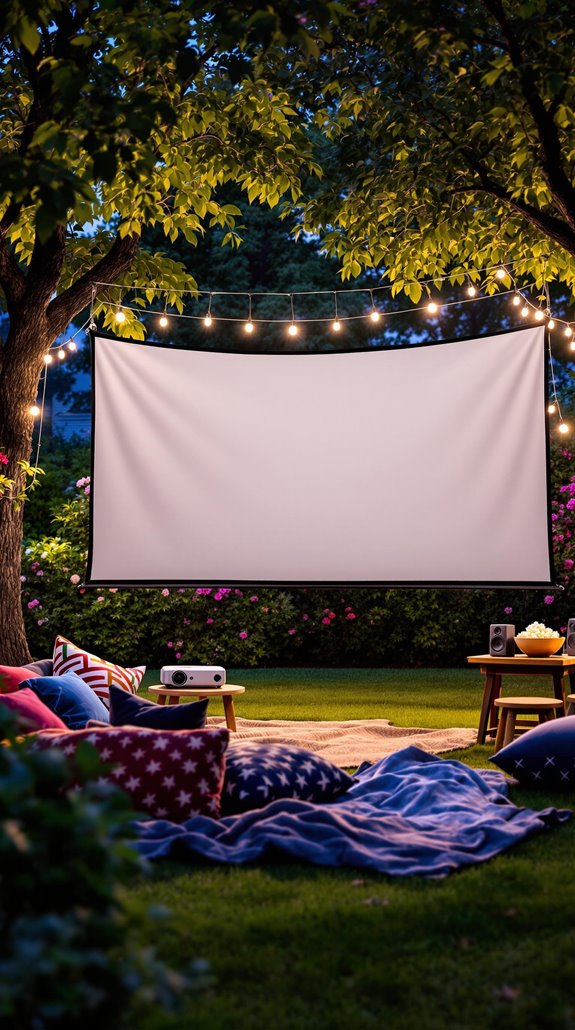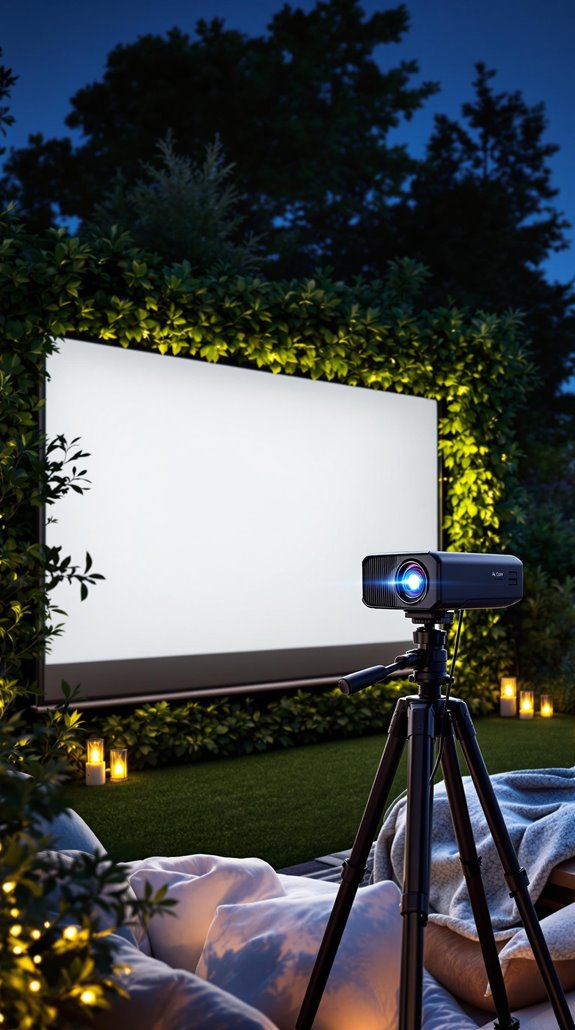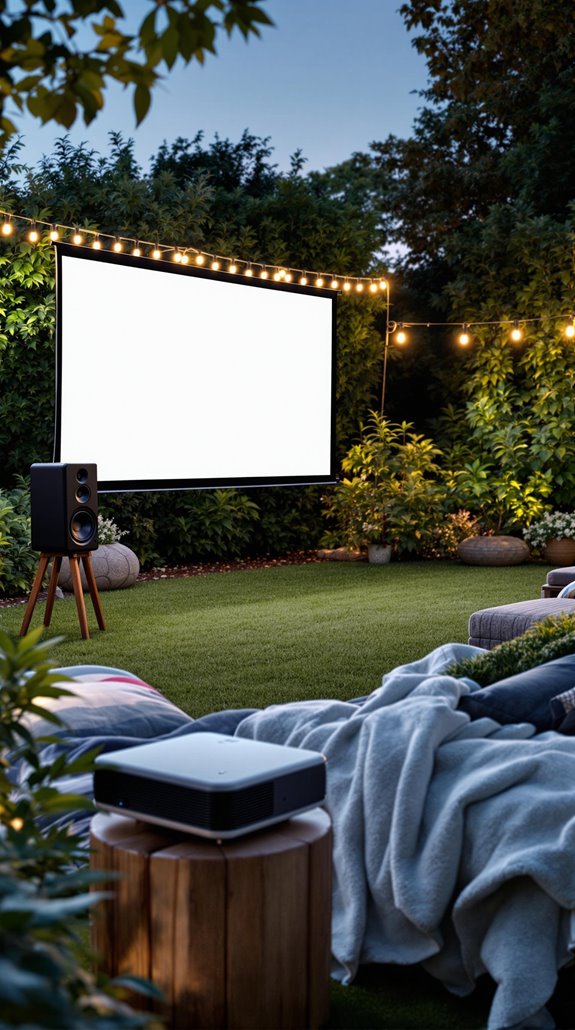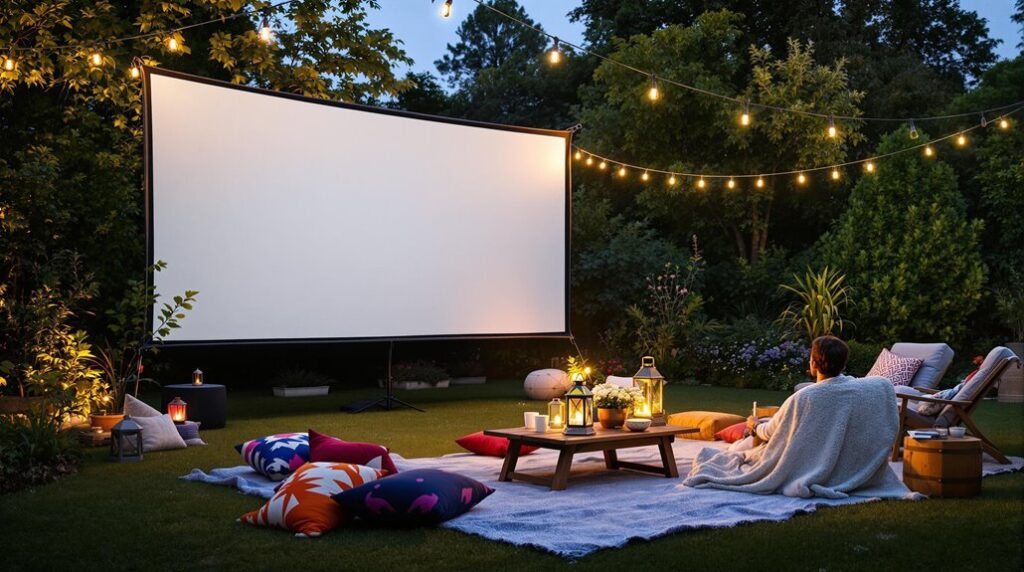I’ve spent countless hours testing outdoor cinema setups, and I can tell you that getting the technical details right makes the difference between a mediocre backyard screening and a truly cinematic experience. The key isn’t just buying expensive equipment—it’s understanding how projector lumens interact with ambient light, how screen materials affect image quality, and why your audio setup will make or break the entire evening. Let me walk you through the critical components that most people overlook.
Key Takeaways
- Choose a high-lumen projector (2,000+ lumens) with weatherproof speakers and a 120-inch inflatable screen for optimal viewing quality.
- Position the projector 5-6 times the screen width away and center it perfectly to avoid image distortion and keystoning.
- Calculate power needs by multiplying equipment wattage by runtime hours, then use portable power stations with backup batteries.
- Set up weatherproof speakers at ear level, angled toward the audience, and test audio-video sync before the screening begins.
- Select stable ground with clear sightlines, anchor the screen with stakes and guide ropes, and add festoon lighting for ambiance.
Essential Equipment for Your Outdoor Cinema Setup

When setting up an outdoor cinema, you’ll need five core equipment categories to deliver a professional viewing experience.
Projection System: I recommend a high-lumen projector (minimum 2,000 lumens) with Full HD or 4K resolution. You’ll want portable design with multiple connectivity options—HDMI, USB, and wireless—plus weather-resistant casing.
Audio Setup: Install six weatherproof speakers for surround-sound immersion. Guarantee Bluetooth/Wi-Fi compatibility and adjustable volume control for varying audience sizes.
Display Screen: Choose inflatable or fixed-frame options with 120-inch ideal sizing. Look for matte white finish with UV/water-resistant materials.
Media and Power: Connect media players through 50ft+ outdoor-rated extension cords. Include backup power banks and stable HDMI connections. Consider portable power stations for venues without easy access to electrical outlets.
Ambient Accessories: Add outdoor-rated seating, festoon lighting, and climate-appropriate gear for complete comfort.
Step-by-Step Screen Assembly and Installation
Setting up your screen requires methodical planning and precise execution to achieve professional results. I’ll guide you through the vital steps that separate amateur setups from cinema-quality installations.
First, I select locations with stable ground and clear sightlines, measuring distances between screen, seating, and projector positions. Next, I assemble the frame following manufacturer specifications, laying fabric white-side up to prevent contamination during setup.
The anchoring process demands precision—I insert rounded stakes through frame feet, then attach guide ropes at 45-degree angles to top corner rings. Adding sandbags provides essential stability in windy conditions. I always perform pressure tests to confirm immobility before proceeding.
Finally, I make site-specific adjustments: rotating to minimize glare, elevating for better sightlines, and verifying unobstructed projector alignment. I ensure the screen maintains proper tension mechanisms to eliminate wrinkles and create a perfectly smooth surface. These techniques guarantee your audience experiences professional-grade outdoor cinema.
Projector Positioning and Configuration Guide

Three critical factors determine projector performance in outdoor settings: distance, alignment, and environmental protection. I’ll position your projector at 5-6 times the screen width distance—my 15-foot screen needs 80-90 feet separation for ideal clarity. I center the projector with the screen’s midpoint, maintaining level alignment to avoid keystoning issues that’ll frustrate your audience.
I elevate the projector using sturdy stands, testing alignment during dusk when conditions match your screening environment. For weather protection, I use waterproof enclosures and anchor everything against wind displacement. I position screens facing north to minimize sunset glare, creating temporary shade with gazebos when needed. After installation, I focus the lens to ensure the sharpest possible image quality for your outdoor viewing experience.
Power Management and Connectivity Solutions
Everything depends on reliable power when you’re miles from the nearest outlet. I’ll help you calculate your power needs by multiplying total equipment wattage by runtime hours—a 200W projector running for 2 hours needs 400Wh capacity. Portable power stations offer the flexibility you need with multiple charging options: AC outlets, solar panels, and car adapters. Solar charging during the day prepares you for evening screenings while backup batteries guarantee uninterrupted viewing regardless of weather conditions.
For off-grid locations, generators provide reliable power but require strategic placement away from your viewing area due to noise. Connect equipment using extension cables to maintain the cinema experience. Weather-resistant power equipment with sufficient outlets accommodates all your devices—projectors, speakers, and media players—creating the seamless outdoor movie night you’ve envisioned. These portable systems require only monthly cleaning and minimal upkeep, making them perfect for regular outdoor entertainment.
Optimizing Audio and Visual Performance

When your projector’s brightness meets perfectly calibrated audio, you’ll create an immersive outdoor cinema experience that rivals indoor theaters. I recommend wireless speakers for maximum flexibility when positioning your sound system around your seating area. You’ll want weather-resistant models that can handle moisture and temperature changes while delivering consistent performance.
Position speakers at ear level, angled toward your audience for ideal sound distribution. Test audio sync with your video source beforehand – nothing disrupts movie magic like delayed dialogue. For larger gatherings, consider powered PA speakers that provide the bass response and volume needed to fill open spaces.
Don’t forget connectivity solutions: use heavy-duty extension cords and audio adapter cables to link your projector’s output to your speaker system. Select the correct input source in your projector’s menu to ensure proper signal routing between your media device and display. Pre-screening tests guarantee everything works flawlessly when showtime arrives.
Best Practices for Weather-Resistant Movie Nights
Perfect audio-visual setup means nothing if Mother Nature decides to crash your movie night. I’ll help you build weather-resistant systems that keep your outdoor cinema running smoothly.
Deploy projector enclosures with unblocked air vents to shield equipment from rain while maintaining cooling. Install sound dampening blower boxes to reduce noise and protect speakers from moisture. For rapid shelter deployment, invest in retractable covers or sturdy patio umbrellas.
Temperature management requires strategic planning. Evening drops of 10-15°F demand portable propane heaters positioned safely in viewer areas. I recommend misting systems for warmer nights and distributing climate-appropriate beverages. Consider providing fleece blankets to enhance audience comfort during cooler fall evenings.
Monitor real-time forecasts using reliable tracking tools and prepare multiple backup plans. Store sensitive electronics in waterproof cases and establish clear evacuation protocols for severe weather.
Conclusion
I’ve covered the essential components and configurations you’ll need for a professional-grade outdoor cinema setup. With proper screen tensioning, projector calibration, and weatherproofing protocols in place, you’ll achieve peak performance metrics. Remember to test your power distribution system and audio synchronization before each screening. Follow these technical specifications, and you’ll have a reliable outdoor theater that delivers consistent results. Your backyard cinema project’s success depends on executing these installation and enhancement procedures correctly.
References
- https://www.crutchfield.com/learn/diy-backyard-movie-theater-guide.html
- https://www.youtube.com/watch?v=c2vZ_Rhj-1U
- https://www.youtube.com/watch?v=lWA6Mfnn7yg
- https://www.bigscreenpro.com/blogs/news/open-air-cinema-home-pro-and-elite-inflatable-screen-lineups-explained
- https://www.benq.com/en-us/knowledge-center/knowledge/basics-of-outdoor-cinema-setup.html
- https://www.premiereoutdoormovie.com/10-must-have-essentials-for-your-next-outdoor-movie-experience
- https://www.bigscreenpro.com/blogs/news/what-is-the-bare-minimum-equipment-for-an-outdoor-movie-screening
- https://sunslifestyle.com/blogs/inspiration/creating-an-outdoor-cinema
- https://www.outdoor-movies.com/drive-in-equipment/
- https://www.blesserhouse.com/how-to-set-up-a-backyard-movie-night-on-a-budget/

